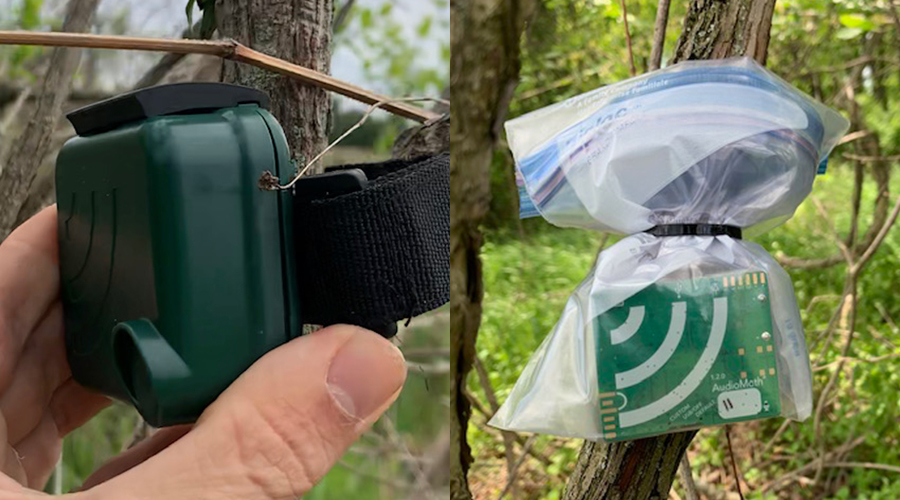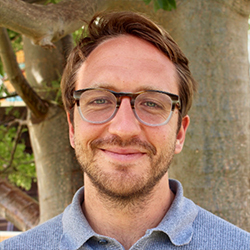
While Johannes Nelson (Master of Environmental Studies ’23—expected) worked as an elementary school teacher in Lebanon, Senegal, and the Dominican Republic, he taught multiple subjects—but he kept coming back to the environment. “A lot of what inspired me about teaching was environmentally focused. By the end of my time teaching, I found that everything was about the environment—even when it was only supposed to be about math,” he recalls. A lifelong outdoors enthusiast and birder, he was drawn to Penn’s Master of Environmental Studies (MES) program because of its alumni and research connections in bird conservation. “Given my specific interests in wildlife conservation and avian ecology, there’s a lot of opportunity in Philadelphia,” says Johannes. “It felt like it was time for me to take the next step.”

Johannes’ first class set him on the path he would continue exploring throughout the program. “I knew I wanted to do environmental or conservation work, but it’s a very broad field. I didn’t know exactly where to start,” he says. In a course dedicated to conservation strategies and research, Johannes learned more about the connection between climate change and biodiversity loss, and discovered a range of approaches to wildlife conservation—including bioacoustics. “Bioacoustics is the analysis and study of living sound,” he explains. An emerging field recently made possible by relatively inexpensive audio recorders and powerful machine learning algorithms, bioacoustics can reveal species that are hidden from view by rocks or brush, track nocturnally active species at night, and cover a wider area and longer timeframe than humans in the field. “The traditional way is sending people out into the field with binoculars to count species—which has worked for a really long time. But with the biodiversity crisis, the decline of animal populations is happening faster than traditional methods are able to keep up with,” says Johannes. “Bioacoustics is faster and more streamlined. And it's an underappreciated part of ecology—you can hear things that you would never be able to see otherwise.”
At Penn, Johannes was able to design an individualized concentration that he calls Bioacoustics and Machine Learning for Conservation, drawing on the MES program’s biology and ecology classes as well as computer science and statistics courses from departments across Penn. “I got really interested in where ecology and technology intersect, so the flexibility became the program’s greatest strength for me," he says. “I came in thinking that I was going to get out in the field and have my boots in the mud every day. And I did, but I’ve also been doing a lot of programming and coding.” Through electives, Johannes studied machine learning models and neural networks that could be applied to identify the calls and vocalizations of specific species and to pick them out from thousands of hours of audio data. “It’s the same type of artificial intelligence models that are in the news these days, like ChatGPT or the model that recognizes faces on your iPhone. That’s what I’m doing with sound: I’m turning it into a visual representation and doing image recognition on it,” he explains. “It’s an exciting direction for me to take with these powerful tools that are underutilized in fields like conservation and climate science.”
Bioacoustics and machine learning algorithms can help government agencies, land trusts, and other organizations to monitor the population of endangered or sensitive species—especially those that are nocturnally active or otherwise difficult to locate. Platforms like BirdNET have been trained to quickly and accurately identify many species of birds; avian enthusiasts can even download an app to identify bird calls in the field. But there are many other species whose vocalizations are not well represented in the training data, and which are difficult to monitor in person. For example, Johannes is doing his capstone research at the Great Marsh Institute in Chester County, Pennsylvania, using bioacoustics to locate a population of marsh birds called Virginia rails. “Those birds are cryptic, and stay hidden in the brush. You hardly ever see them,” he says. “When you do detect them, it’s most often through the calls they make.” Johannes placed small, waterproof audio recorders throughout the marsh in plausible rail habitats, and took two weeks’ worth of audio recordings. At first, he intended to scan the audio data for information about the rails: how many, where they are located, what habitat variables affect whether or not they are present. “But then I saw that there are so many different ways to process the audio,” he continues. “So now I am probably doing more of a methods paper that shows how I collected and processed the audio, so anyone else who's looking to develop models for specific birds would be able to follow those steps.”
Johannes has already found another opportunity to put his methods to work for a project focused on owl populations, and hopes to continue assisting organizations to record and process audio data on a professional basis—anywhere that needs help. “I'd love to be able to work remotely with projects in different parts of the country,” he says. “The field work involves putting the recorders out or setting up your survey, but you can do a lot of this work remotely if you have access to the audio data. I’m open to the world.”





